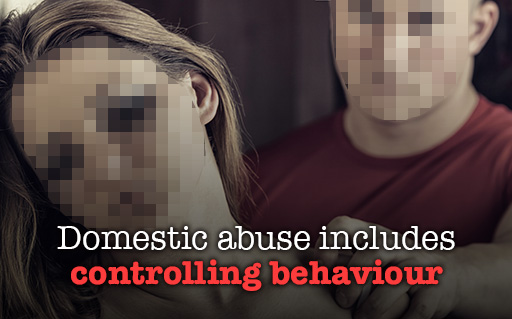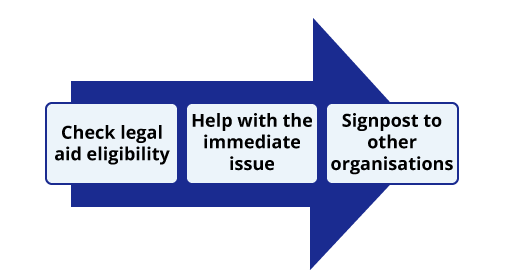Use 'Print preview' to check the number of pages and printer settings.
Print functionality varies between browsers.
Printable page generated Thursday, 20 November 2025, 5:15 PM
Supporting clients who are accused of perpetrating domestic abuse
3.1 Introduction
Welcome to this third and final training module on supporting clients who are accused of perpetrating domestic abuse. There are three domestic abuse modules and they are designed to be studied in order, from the first to the third. These modules are:
- Introducing domestic abuse
- Supporting survivors of domestic abuse
- Supporting clients who are accused of perpetrating domestic abuse

Have you completed the second domestic abuse module, Supporting survivors of domestic abuse?
If you have not yet studied the second domestic abuse module, please do this before studying this second module. Go to Supporting survivors of domestic abuse.
Approximately 1 in 10 cases you deal with will feature domestic abuse. You will come across people who have experienced domestic abuse, perpetrators of abuse and those who have been accused of causing abuse. For some people, their experiences may make it more difficult for them to be involved with the court system, particularly where their case involves the alleged perpetrator of abuse. These training modules will assist you in feeling more confident in supporting clients in these situations.
Support Through Court do not want or expect volunteers to ‘diagnose’ domestic abuse or to become overly involved with clients. A three-step process for supporting clients where domestic abuse is a feature of the case is described later in this module.
Please note
This module deals with some sensitive issues including descriptions of domestic abuse. These training modules are not compulsory, but they are recommended. If you do not feel comfortable to start the module, or if you are affected by the material, or feel you are unable to undergo the training, then Support Through Court can help you. Please speak to your Service Manager when you are next in the office.
If you need immediate support over the phone you can call:
National Domestic Violence Helpline – 0808 200 247
Learning outcomes
This third training module will help you to support clients who are accused of perpetrating domestic abuse. For example, as respondents in non-molestation applications or child arrangements cases where the other party is alleging our client has perpetrated domestic abuse against them.
In this module you will learn about:
- The importance of understanding domestic abuse
- How to support alleged perpetrators of domestic abuse
- How to maintain appropriate boundaries when supporting alleged perpetrators.
This module is one of a number of training modules to help Support Through Court volunteers when supporting clients. The modules all use the same case study to explore the different aspects of supporting clients effectively. We will be referring to this example as we work though this module, so it may be helpful to remind yourself of the facts now. You may want to open this case study in a separate window (use Ctrl + click on the link) so you can refer back to it when needed. Find out more about the fictitious Johnson/Smith family and their situation.
During the module you may come across terminology which is unfamiliar to you. Some words are hyperlinked to the Glossary, so by hovering over the word you will be able to see its definition.
Statistics around domestic abuse show that women are more likely to be victims of abuse than men. For this reason, during the module we will be using ‘she’ to denote the survivor of domestic abuse and ‘he’ to denote the perpetrator, as this is the scenario you are more likely to come across in your volunteering.
However domestic abuse can involve men as survivors and women as perpetrators, as well as abuse within same sex relationships. Support Through Court supports all clients regardless of their circumstances and so you may come across different forms of relationships in your volunteering. This training will assist you to support clients whatever their gender or sexual orientation and regardless if they are alleged to have abused or are making allegations.
Domestic abuse used to be called Domestic Violence and some people still refer to it like that. However, because physical violence is only one form of domestic abuse, these days the broader term Domestic Abuse is preferred.
Whilst thinking about terminology we use the term ‘survivor’ in preference to ‘victim’ as ‘survivor’ implies an active, creative, resourceful response (Women’s Aid, 2020). However, both terms can be used interchangeably, depending on the context.
Give your opinion
How would you rate your understanding of supporting clients who are alleged to be perpetrators of abuse, right now, before you start this module? Submit your answer.
3.2 Why is it important to understand domestic abuse?
In the first training module, Introducing domestic abuse, we defined domestic abuse , using the Home Office definition, as being:
“Any incident or pattern of incidents of controlling, coercive or threatening behaviour, violence or abuse between those aged 16 or over who are or have been intimate partners or family members regardless of gender or sexuality. This can encompass, but is not limited to, the following types of abuse: psychological; physical; sexual; financial; emotional.”
We focused on coercive and controlling behaviour, where the perpetrator acts to exert power and control in the relationship through a range of abusive behaviours.
Activity 1
What types of coercive or controlling behaviour have you heard about, either in the first domestic abuse training module or in your volunteering at Support Through Court?
Comment
Controlling behaviour involves the perpetrator removing the survivors’ ability to make choices for themselves and exercise their freedom to act in their personal, social, economic and political life. Examples might include depriving them of money, isolating them from friends and family or making rules about what they can and can’t do in their everyday lives.
Coercive behaviour involves threats, intimidation or humiliation, to harm, punish or frighten the survivor. Examples might include violent outbursts, shouting and swearing, belittling the survivor or threatening the children, to ensure the survivor behaves in the way they want and is frightened and powerless within the relationship.
Sometimes individual acts which make up a pattern of coercive and controlling behaviour can be difficult to identify, particularly for the survivor, who has become used to the behaviour and to the reasons given by the perpetrator for acting in that way. Often these reasons may be about caring for the survivor or looking after them.
In the first domestic abuse training module, introducing Domestic Abuse, we considered how we could use Duluth’s power and control wheel as a way of helping survivors (and those supporting them) to identify the different control tactics perpetrators use against them.
Hover over each segment of the wheel below to display the full definitions.
In the first domestic abuse training module we also explored the losses and gains a survivor experiences when deciding whether to leave the relationship, or restart it. Understanding this can help you to support clients through being non-judgemental, identifying support for survivors and empowering survivors to make appropriate choices.
Activity 2
A difficult and potentially dangerous time for a domestic abuse survivor is where they are brought back into contact with the perpetrator through court proceedings, most typically divorce and financial arrangements or child arrangement proceedings. Why might this be a vulnerable time for a domestic abuse survivor?
Comment
You may have thought of a number of reasons why this time could be particularly dangerous for a domestic abuse survivor. There will be some contact between the survivor and perpetrator due to the court proceedings and they will usually see each other at any court hearings. This may be an opportunity for a perpetrator to try and reconcile with the survivor so the relationship starts again.
You may also recall from the first training module that the perpetrator may also be unsettled by the loss of control in the relationship, particularly where a court makes a decision which the survivor has asked for. This may also provoke a violent response from the perpetrator.
Being aware of the potential risks survivors may face when leaving the relationship or being involved in court proceedings can help you to support both survivors and alleged perpetrators of domestic abuse.
As we work though this module, please remember the importance of understanding what domestic abuse is, the control tactics perpetrators use, why survivors might find it difficult to leave a relationship and the risks involved in court proceedings where domestic abuse is involved. This will help you to better support both survivors and alleged perpetrators. We will look at how to support alleged perpetrators in the next section of this module.
3.3 Supporting alleged perpetrators of domestic abuse
Support Though Court supports clients irrespective of allegations made about them. You will therefore come across situations where you are asked to support a client who is alleged to be a perpetrator of domestic violence. It is important for you to manage your boundaries appropriately, and to control any feelings of revulsion, either due to the allegations made against them or the way they behave in the court building.
For example, your reaction could lead you to be under-involved in their case, or not engage fully with their needs. As a Support Through Court volunteer, you are not there to judge, but to support all clients regardless of allegations made about them. However, if you feel that you are unable to support a client - for whatever reason - speak with your Service Manager at the earliest opportunity.
Activity 3
However, there are issues which might arise specifically when supporting a client who is an alleged perpetrator and we will now consider those issues and the care that is needed when supporting such clients.
Please watch this video from Respect and answer the following questions. Please note this video is aimed at healthcare professionals so there are some things that are discussed which may seem out of context at Support Through Court. Don’t worry about this.

Transcript
When discussing the relationship perpetrators may deny, minimize and blame. They may present as having a sense of entitlement, particularly in regard to women. This is often called ‘male privilege’. They use a variety of common excuses to explain their behaviour such as drugs and alcohol, mental health, stress or childhood experiences. They can come across as plausible, sensible and charming.
When supporting alleged perpetrators, remember the advice given in the second domestic abuse module ‘Supporting Survivors of Domestic Abuse’. The same process applies when supporting alleged perpetrators.
First check legal aid eligibility (can they provide evidence of domestic abuse perpetrated against them?). Then help with the immediate issue they have come to see you about. What can they do without a solicitor?
Focus on their case and help them to understand where the domestic abuse fits in with the decision-making process of the court. Finally, consider if you can signpost them to other organisations who may be able to help.
3.4 The importance of maintaining appropriate boundaries when supporting alleged perpetrators
There are some common behaviours or experiences volunteers report when supporting alleged perpetrators of domestic abuse, which we will discuss below. Being aware of these will help you to support clients appropriately by maintaining appropriate boundaries. By this we mean being clear about what you can and cannot help clients with, and what you will and will not say. Understanding these guidelines will help you support clients appropriately whilst being aware of possible risks to yourself and the other parties involved in the court proceedings.
Activity 4
As a volunteer when responding to counter allegations (particularly where there is the possibility that they are fabricated by an alleged perpetrator, be careful not to offer the following common (but problematic) responses.
| Colluding with the abuser | This is problematic as collusion may embolden the perpetrator |
| Minimising or excusing his behaviour, or blaming it on the survivor | This is problematic as it is in effect taking sides and adopting a non-neutral stance |
| Offering ‘anger management’ solutions or programmes | This is problematic as domestic abuse is not due to anger issues; as we have learnt through these training modules, it is a systematic crime which is often due to issues around power and control |
| ‘50:50’ responses where the survivor and perpetrator are equally blamed | This is problematic as it implies an unhealthy relationship rather than one where domestic abuse is involved |
| Reframing the domestic abuse into ‘family conflict’ | This is problematic as it implies the 50:50 response referred to above |
| Seeing the perpetrator as the survivor | This is problematic as if the perpetrator has persuaded you, they may be encouraged to obstruct the process believing they will get what they want |
Find out more
To find out more about how some perpetrators may present as victims, go to this information.
3.5 Supporting Steve Smith as an alleged perpetrator of domestic abuse
We are now going to look for the final time at our case study, the Johnson/Smith family. Remind yourself of the family and their situation.
Jazmin has applied for a child arrangements order in respect of Chloe. When the application for a child arrangement order is sent to Steve, he comes into the Support Through Court office to seek advice on what he needs to do next.
Steve tells you that Jazmin has made unfounded allegations about him being violent towards her in order to extort money from him through child support payments. He alleges that the injury to Jazmin was caused by her drug dealer as she owed money to him. He says that he provided everything for her and the children but that whatever he did was not enough for her.
He says that Jazmin struggled to parent the two children and used drugs and alcohol around the children. He says he had to look after the children as well as work to support them and so he is worried about her looking after Chloe. He is angry that he does not know where his daughter is living and that he has not had any contact with her since Jazmin left three months ago.
He then goes on to say that Jazmin was very volatile and emotional and would shout, scream and throw things when she did not get her own way. He spoke about being hit by items thrown at him. He says he worries that Jazmin is not fit to care for either of the two children and that she may pose a risk to them due to her violent behaviour and drug use. He wants his daughter Chloe to live with him. If this does not happen immediately then he wants contact with her overnight whenever he is not working and to know where they are living with Jazmin.
He repeatedly says that he knows he will not get a fair hearing as the courts will take the side of the mother, particularly given the untrue allegations she has made. He also is worried about the cost of proceedings.
Activity 5
Thinking about how you will respond to Steve, please answer the following questions. There is one correct answer to each question.
a.
Say how sorry you are to hear this and ask for further details to include in his statement.
b.
Suggest relationships can be difficult and things can easily get out of hand.
c.
Explain how the court will take allegations of domestic violence into account in the child arrangements order and ask whether he can provide evidence of Jazmin’s violence.
d.
Tell him he is a liar and that statistically he is more likely to have been violent towards Jazmin.
The correct answer is c.
Answer
The correct answer is explain how the court will take allegations of domestic violence into account in the child arrangements order and ask whether he can provide evidence of Jazmin’s violence.
Feedback
The other responses either collude in his allegations or are judgemental.
a.
Explain that he might be eligible for legal aid if he can evidence domestic abuse and is of low income, signpost him to a list of Legal Aid Family solicitors or go through the Legal Aid Checker with him online.
b.
Explain he can represent himself and explain how the proceedings will run.
c.
Suggest he should think about paying for a solicitor as Jazmin will probably be eligible for legal aid due to her allegations of domestic abuse.
d.
Sympathise with his situation and the fact that Jazmin has put him in this situation.
The correct answer is a.
Answer
The correct answer is explain that he might be eligible for legal aid if he can evidence domestic abuse and is of low income, signpost him to a list of Legal Aid Family solicitors or go through the Legal Aid Checker with him online.
Feedback
As he has made allegations of domestic abuse, he may be eligible for legal aid if he can evidence the abuse and his income is below the financial limits.
a.
Agree that this appears to be part of the lies Jazmin is making about him.
b.
Explain that the court has made a procedural order to withhold the address but that this will not affect the main hearing of the case and is something he can ask the court to look at again during that hearing.
c.
Explain the order was due to the significant allegations of violence made by Jazmin and is unlikely to be changed as her allegations are credible and serious.
d.
Sympathise that it is difficult for a father not to know where his child is living.
The correct answer is b.
Answer
The correct answer is explain that the court has made a procedural order to withhold the address but that this will not affect the main hearing of the case and is something he can ask the court to look at again during that hearing.
Feedback
The other responses are either judgmental or collude with Steve.
a.
Explain there is no point in challenging the application as the courts will usually prefer the mother, particularly where allegations of violence are made.
b.
Suggest he needs to make an immediate application as the children may be at risk of harm from Jazmin and show him the forms to do this.
c.
Explain which forms he needs to complete to defend the application and what will happen next.
d.
Suggest he sees a solicitor as it is a complex case due to the
The correct answer is c.
Answer
The correct answer is explain which forms he needs to complete to defend the application and what will happen next.
Feedback
You need to help him with the immediate issue at hand, as you would for any other client. There does not appear to be any evidence provided by Steve that the children are at immediate risk of harm and this may be a tactic to use the child arrangements application to further harass and intimidate Jazmin.
3.6 Your volunteering and supporting clients who are alleged to be perpetrators of abuse
Activity 6
Thinking about what you have learnt about supporting clients who are alleged to be perpetrators of abuse, please complete the following questions.
Give your opinion
How would you rate your understanding of supporting clients who are alleged to be perpetrators of abuse, after completing this module? Submit your answer.
3.7 Conclusion
This module has helped you to understand how to best support alleged perpetrators of domestic abuse in your volunteering with Support Through Court.
In this module you have learned about:
- The importance of understanding domestic abuse
- How to support alleged perpetrators of domestic abuse
- How to maintain appropriate boundaries when supporting alleged perpetrators.
You have now completed the three domestic abuse modules. They were:
- Introducing domestic abuse
- Supporting survivors of domestic abuse
- Supporting clients who are accused of perpetrating domestic abuse
Congratulations on completing the three domestic abuse modules. You can come back to these modules to refresh your memory or to find relevant information at any time.
Support Through Court have a suite of training modules which you can complete so please do take a look at the other modules available. You can study these in any order. They include:
- Special measures
- Working with Cafcass
- Interviewing clients
- Writing statements
- Signposting clients to other organisations
- Working with vulnerable people
Give your opinion
Well done, you have completed this module.
How much will this module, supporting clients who are alleged to be perpetrators of abuse, help you with your volunteering? Submit your answer.
3.8 Modules 1–3 knowledge assessment
This knowledge assessment contains 10 questions. The pass mark is 80% and you have unlimited attempts at the assessment.
This assessment counts towards your digital badge and Statement of Participation.
Go to the Modules 1–3 knowledge assessment now and gain your digital badge.
References
Acknowledgements
Grateful acknowledgement is made to the following sources:
Every effort has been made to contact copyright holders. If any have been inadvertently overlooked the publishers will be pleased to make the necessary arrangements at the first opportunity.
Important: *** against any of the acknowledgements below means that the wording has been dictated by the rights holder/publisher, and cannot be changed.
266485: 3.1 Support through court logo: Support through court
273319: 3.2 Controlling behaviour: Adapted from Artem Furman / Alamy Stock Photo
271083: 3.2 Duluth power and control wheel interactive: 'Duluth wheel of power and control’, Domestic Abuse Intervention Program (DAIP), https://www.theduluthmodel.org/wheels/
269565: 3.3 Respect logo: Used with permission of Respect
266472: 3.5 Steve: tommaso79 / iStock / Getty Images Plus
Video and Audio
271652: 3.3 Respect video ‘Working with Perpetrators of Domestic Violence’: Used with permission of Against Violence & Abuse (AVA) and Respect


